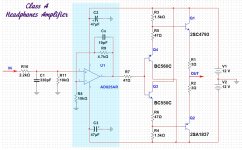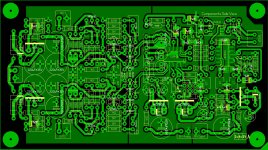Blade Runner SACD
You have good taste, then.
Now I feel like watching DUNE.
You have good taste, then.
Now I feel like watching DUNE.
Maybe to do opAMPs on output - LT1469 in i-v and LT1122 in filter (and made on output small class A amplifier as optional)?
Attachments
PCM1704 with discrete IV = PASS D1
Didiet
thanks
The biggest advantage (after drive capability) for a discrete output stage is the ability to keep the switching noise away from the opamp's power rails through judicious filtering. I suggest LC or RC on the opamp's power or alternatively shunt regs.
I think that I'll build 2 DACs with discrete and opAMPs output, and compared them.
Maybe to do opAMPs on output - LT1469 in i-v and LT1122 in filter (and made on output small class A amplifier as optional)?
Nice idea.
You can consider LT1363 in I/V and LME49990 in LPF.
Intense detail + virgin purity.
Last edited:
I don't like LME49860 either, only LME49990 in high gain with LME49990 buffer, 4x total.
They say LT1363 sounds better in Class-A bias, I haven't tried that yet.
I will order LT1469 and LT1122 later.
PCB for AD1853+discrete (not my).
I draw 2 layers PCB for AD1853+opAMPs, then will draw 2 layers PCB for discrete output.
Attachments
Have a look at this schematic for a few ideas
http://www.diyaudio.com/forums/solid-state/255236-opamp-based-power-amp.html
Later in the thread, LTspice simulation achieves -160 dB!
http://www.diyaudio.com/forums/solid-state/255236-opamp-based-power-amp.html
Later in the thread, LTspice simulation achieves -160 dB!
Nice project.
Not enough information about the sound of discrete output: "the sound of discrete output differs from the traditional opAMPs" and all. Someone like - someone hates.
Have a look at this schematic for a few ideas
http://www.diyaudio.com/forums/solid-state/255236-opamp-based-power-amp.html
Later in the thread, LTspice simulation achieves -160 dB!
and now we rebuilding AD844 and LT1363 on discrete elements...
Have a look at this schematic for a few ideas
http://www.diyaudio.com/forums/solid-state/255236-opamp-based-power-amp.html
Later in the thread, LTspice simulation achieves -160 dB!
I think, that Jean Hiraga's Le Monstre 8W will spread this AMP.
Not enough information about the sound of discrete output: "the sound of discrete output differs from the traditional opAMPs" and all. Someone like - someone hates.
I will link you to a Swiss paper on discrete tomorrow or next day, on phone at the moment.
and now we rebuilding AD844 and LT1363 on discrete elements...
What?
 !!
!!I think, that Jean Hiraga's Le Monstre 8W will spread this AMP.
I want to build a DIY speaker amp, at the moment I only have "JLH", what do you think of Class-D? Which is the best?
I will link you to a Swiss paper on discrete tomorrow or next day, on phone at the moment.
aaaa, not understood.
What?!!
opAMP build on discrete elements : D
I want to build a DIY speaker amp, at the moment I only have "JLH", what do you think of Class-D? Which is the best?
Class D for car's subwoofer only. JLH much worse than Jean Hiraga's Le Monstre 8W and Super Class A 20/30W. I almost smashed JLH 1996 after made and heard Hiraga.
What does a current out DAC need?
Low Input resistance of the I/V (although a switched capacitor output stage as the AD1853 is not that sensitive, R2R DACS are much more picky). This impedance should be as flat as possible over a broad frequency range, as the DAC spits out, inherently, a high amount of HF components.
The shown discrete Output stage is NOT an OP Amp style stage, but common base open loop.
It has a low input impedance, which rises way later in the frequency band than a op amp I/V (which relies only to a high Loop gain, and it decreases quickly with rising frequency.
I suggest you to leave the discrete output stage as it is (at least from a topology view). You may look to increase the bias current through VT4-8, it gets better when their bias current is >> max current swing of AD1853 (AFAIR +/-3mA).
I'd bias them at least to 10mA.
Anyway, common base stages are the way to go for DAC I/V.
Low Input resistance of the I/V (although a switched capacitor output stage as the AD1853 is not that sensitive, R2R DACS are much more picky). This impedance should be as flat as possible over a broad frequency range, as the DAC spits out, inherently, a high amount of HF components.
The shown discrete Output stage is NOT an OP Amp style stage, but common base open loop.
It has a low input impedance, which rises way later in the frequency band than a op amp I/V (which relies only to a high Loop gain, and it decreases quickly with rising frequency.
I suggest you to leave the discrete output stage as it is (at least from a topology view). You may look to increase the bias current through VT4-8, it gets better when their bias current is >> max current swing of AD1853 (AFAIR +/-3mA).
I'd bias them at least to 10mA.
Anyway, common base stages are the way to go for DAC I/V.
JLH much worse than Jean Hiraga
How does the Hiraga sound?
Plus, from where did you purchase the Hiraga PCB? I have JLH 2001.
DAC will be not work on low impendance, 1 mA maximum output current. 10 mA bias can damage BJT (300 mW maximum).What does a current out DAC need?
as current is >> max current swing of AD1853 (AFAIR +/-3mA).Low Input resistance of the I/V (although a switched capacitor output stage as the AD1853 is not that sensitive, R2R DACS are much more picky). This impedance should be as flat as possible over a broad frequency range, as the DAC spits out, inherently, a high amount of HF components.
The shown discrete Output stage is NOT an OP Amp style stage, but common base open loop.
It has a low input impedance, which rises way later in the frequency band than a op amp I/V (which relies only to a high Loop gain, and it decreases quickly with rising frequency.
I suggest you to leave the discrete output stage as it is (at least from a topology view). You may look to increase the bias current through VT4-8, it gets better when their bi
I'd bias them at least to 10mA.
Anyway, common base stages are the way to go for DAC I/V.
I think too - build DAC with opAMPs (and to make discrete output for interest).
About R2R - do you have good scheme on PCM1702 (it's alone multibit, that I can to get in my city (PCM1702U-K))?
- Status
- This old topic is closed. If you want to reopen this topic, contact a moderator using the "Report Post" button.
- Home
- Source & Line
- Digital Line Level
- DAC AD1853 with discrete output

